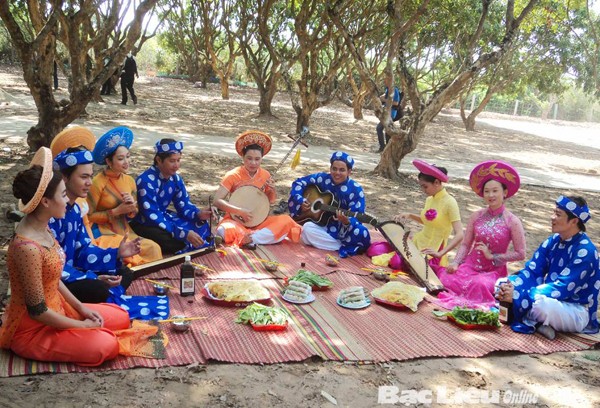(VOVworld) - Don Ca Tai Tu's music from southern Vietnam was officially recognized by UNESCO as an Intangible Cultural Heritage of Humanity on December 5. This recognition opens a new development period for this folk art form of Vietnam.
 |
| A performance of Don Ca Tai Tu (Photo: Bao Bac Lieu) |
Don Ca Tai Tu means music performed by either talented or amateur performers. The music originates from the five-tone music which was developed in the 17th century from the Hue Royal Court music and music of the south-central region. Nguyen Van Tan, former chief representative of the Ministry of Culture, Sports and Tourism in Ho Chi Minh city, says Don Ca Tai Tu has an interesting history:“A milestone in Vietnam history is the reclamation of the southern land, which left valuable legacies, including Don Ca Tai Tu. The music is the continuation and inheritance of the traditional music of the northern and central regions. We know that Don Ca Tai Tu has traces of the Hue Royal Court music and reflects the broad-mindedness and creativity of the southerners”.
In the early 20th century, Don Ca Tai Tu became a popular musical movement in the south. Musician Nguyen Quang Loi, who resettled in Can Duoc from the Hue Royal Court in the central region, led the of in Vinh Long province. Ky Quon, a Hue born resident of Vinh Long province, led the art troupes of the Southwestern region. They were vanguard compilers, composers, and lecturers of Don Ca Tai Tu.
This art form’s peculiarity is its improvisation, like American jazz. On the basis of the traditional format, artists supplement ligature, making it their own version. Don Ca Tai Tu has many melodies, one of the most popular being Da Co Hoai Lang. The name means “Listening to the sound of drums at night, missing one’s husband”. It was written by Cao Van Lau in Bac Lieu in 1917.
According to UNESCO’s assessment, this musical genre has met the criteria to be included on the Representative List of the Intangible Cultural Heritage of Humanity. It has been passed down from generation to generation through official and unofficial forms of education in all 21 provinces where the art form is popular. Don Ca Tai Tu has continuously been popularized through cultural exchanges among peoples, showing their mutual harmony and respect. Nguyen Van Tan told VOV: “UNESCO’s recognition of Don Ca Tai Tu as an Intangible Cultural Heritage acknowledges the heritage’s uniqueness and its widespread influence in the southern region. This is also a prerequisite to preserve and utilize heritage values for socio-economic development, particularly in tourism and culture”.
During its more than a century of existence, Don Ca Tai Tu has proved its vitality, being performed at weddings, death anniversaries, birthday celebrations, and public gatherings. Musicians play traditional instruments, including a two-stringed guitar called a Dan Kim, to accompany singers who carry the audience through different tones of emotion.